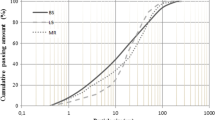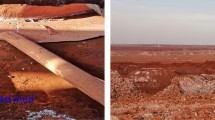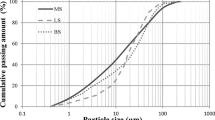Abstract
Addition of pozzolanic materials increases the mechanical characteristics of construction materials and contributes towards a higher durability. Metakaolin is an artifical pozzolan obtained by calcination of kaolinitic clays at an adequate temperature. Geopolymers are inorganic materials from mineral origin, composed of a precursor, an alkaline activator and a solvent. New geopolymer formulations were designed by sodium silicate/NaOH/KOH activation of metakaolin, zeolites, diatomites and red mud mixtures. The effects of source materials on the microstructure and mechanical properties were studied. Mineralogical and chemical compositions were assessed as well as microstructure, specific surface area, compressive strength and adsorption. In general, incorporation of red mud, zeolite filler and diatomites to metakaolin in medium of alkali activators of low concentration provided formation of more eco-friendly materials with high mechanical resistances and water treatment capabilities.
You have full access to this open access chapter, Download conference paper PDF
Similar content being viewed by others
Keywords
1 Introduction
Addition of pozzolanic materials increases the mechanical characteristics of construction materials and contributes towards a higher durability. Metakaolin is an artifical pozzolan obtained by calcination of kaolinitic clays at an adequate temperature. Metakaolin is the structurally disordered product obtained following the dehydroxylation of kaolin, more precisely of its essential component kaolinite - Al2Si2O5(OH)4.
Geopolymers are inorganic materials from mineral origin, composed of a precursor, an alkaline activator and a solvent. The process of geopolymerization involves a chemical reaction that takes place in an alkaline medium, resulting in the formation of inorganic polymers that have silicon and aluminum as main constituents (Si+Al), connected by oxygen ions. The solution becomes alkaline using activators such as sodium and potassium hydroxides and/or sodium and potassium silicates.
Depending on the composition, geopolymer characteristics can be attained in terms of physical, chemical and mechanical performance (Mackenzie and Welter 2014). Moreover, geopolymers have the advantage to be possibly formulated from a wide range of aluminosilicate minerals.
2 Methods and Approaches
New geopolymer formulations were designed by sodium silicate/NaOH/KOH activation of metakaolin, zeolites, diatomites and red mud mixtures. The effects of source materials on the microstructure and mechanical properties were studied.
Geopolymers were prepared using commercial metakaolin (1200S, AGS Mineraux, France, D50 = 1.1 μm, bulk density = 296 g/dm−3), diatomite from Rio Maior and Amieira deposits (Portugal), zeolite (ZeoBau micro 50, from Nižný Hrabovec, Zeocem, Slovakia, CEC = 83 meq/100 g, SSA = 1663 m2/kg, particle size 0–0.05 mm, bulk density = 500–600 g/dm−3, more information about Nižný Hrabovec deposit is available on http://www.iza-online.org/natural/), red mud from aluminium metallurgies wastes, hydrated sodium silicate (Merck, Germany Merck, Germany; 8.5 wt% Na2O, 28.5 wt% SiO2, 63 wt% H2O) and sodium and potassium hydroxide (ACS AR Analytical Reagent Grade Pellets).
The role of the above ingredients in the preparation of geopolymers is as follows: metakaolin was used as a precursor of aluminium; diatomite was used as a precursor of silica; zeolite was used as filler with high specific surface area and cation exchange capacity; red mud as precursor of aluminium and iron; sodium silicate was used as a source of silicon and sodium and potassium hydroxide as alkaline activators for dissolution of aluminosilicate. Water was the reaction medium.
The X-ray diffraction was conducted on Philips X’Pert diffractometer using CuKα radiation at a speed of 0.02°/s. The X’Pert HighScore (PW3209) program was used to analyze XRD peaks. The chemical composition (major elements) of materials was analysed using PANalytical Axios X-ray fluorescence spectrometer. Loss on ignition was determined by heating the samples in an electrical furnace at 1000 °C during 3 h. The microstructural characterization was carried out by scanning electron microscopy (SEM – Hitachi, SU 70) and energy dispersive X-ray spectrometry (EDS – EDAX with detector Bruker AXS, software: Quantax) operated at 3–30 kV.
The specific surface area of geopolymers (heated at 200 °C during 6 h) was determined by BET method (Brunauer, Emmett and Teller, nitrogen gas adsorption at 77 K) (Brunauer et al. 1938). Compressive strength tests were carried out on 3 probes of individual geopolymer on (SHIMADZU: AG-IC 100 kN) equipment, by applying a maximum force of 5 kN at the speed of 50 N/s according to the Standard EN 1015-11. Adsorption experiments were carried out in batch using nitrate solutions of Pb2+, Zn2+, Cu2+, Cd2+ and Cr3+.
3 Results and Conclusions
Performed analyses confirm that zeolite particles are responsible for higher amount of crystalline phases producing more compact and firm microstructure of blended geopolymers relative to that of reference MK100. SEM analysis reveals that incorporation of 50 wt% of zeolite to metakaolin geopolymer (MK50) leads to the denser geopolymer matrix related to microstructure when compared to 100 wt% metakaolin in reference geopolymer (MK100). Dense microstructure of MK50 manifests in its considerably lower water adsorption and specific surface area values.
All geopolymers containing zeolite show increase in compressive strength compared to pure metakaolin one, with optimal ratio metakaolin precursor/zeolite filler 50:50 providing the highest compressive strength (8.8 MPa at 28 days). The adsorption of heavy metals increases as the amount of metakaolin in the structure increases.
Diatomite enriched formulations showed different evolutions according to the Na or K activator; those K activated showed higher compressive strength.
The well-known geopolymer composition (amorphous phase predominant over residual quartz, illite and anatase) is slightly affected by the red mud, despite it provides aluminum and iron oxides and oxy-hydroxide (hematite, goethite, gibbsite and boehmite). These phases, in fact, are to a limited extent involved in the geopolymerization process and the alkaline aluminosilicate amorphous phase is about 90 wt% in all samples. The structural features of the amorphous geopolymer, as resumed by the broad hump of XRD patterns, are not modified by addition of RM.
The physical properties of geopolymers are not significantly affected by RM, as all samples exhibit high values of water absorption and low apparent density. The chemical stability is good: sodium leaching test gave leachate concentrations close to 100 ppm without evidences of deterioration of mechanical performance. Red mud influences the mechanical strength during curing (especially at the higher amounts of RM but the lower additions, cured for 28 days showed good compressive strength).
In general, incorporation of red mud, zeolite filler and diatomites tometakaolin inmedium of alkali activators of low concentration provided formation of more eco-friendly materials with high mechanical resistances and water treatment capabilities.
References
Brunauer S, Emmett PH, Teller EJ (1938) Adsorption of gases on multimolecular layers. J Am Chem Soc 60:309–319
Mackenzie K, Welter M (2014) Geopolymer (aluminosilicate) composites: synthesis, properties and applications. Adv Ceram Matrix Compos. 445–470
Author information
Authors and Affiliations
Corresponding author
Editor information
Editors and Affiliations
Rights and permissions
Open Access This chapter is licensed under the terms of the Creative Commons Attribution 4.0 International License (http://creativecommons.org/licenses/by/4.0/), which permits use, sharing, adaptation, distribution and reproduction in any medium or format, as long as you give appropriate credit to the original author(s) and the source, provide a link to the Creative Commons license and indicate if changes were made.
The images or other third party material in this chapter are included in the chapter's Creative Commons license, unless indicated otherwise in a credit line to the material. If material is not included in the chapter's Creative Commons license and your intended use is not permitted by statutory regulation or exceeds the permitted use, you will need to obtain permission directly from the copyright holder.
Copyright information
© 2019 The Author(s)
About this paper
Cite this paper
Rocha, F., Costa, C., Hajjaji, W., Andrejkovičová, S., Moutinho, S., Cerqueira, A. (2019). Properties Improvement of Metakaolin-Zeolite-Diatomite-Red Mud Based Geopolymers. In: Glagolev, S. (eds) 14th International Congress for Applied Mineralogy (ICAM2019). ICAM 2019. Springer Proceedings in Earth and Environmental Sciences. Springer, Cham. https://doi.org/10.1007/978-3-030-22974-0_92
Download citation
DOI: https://doi.org/10.1007/978-3-030-22974-0_92
Published:
Publisher Name: Springer, Cham
Print ISBN: 978-3-030-22973-3
Online ISBN: 978-3-030-22974-0
eBook Packages: Earth and Environmental ScienceEarth and Environmental Science (R0)




